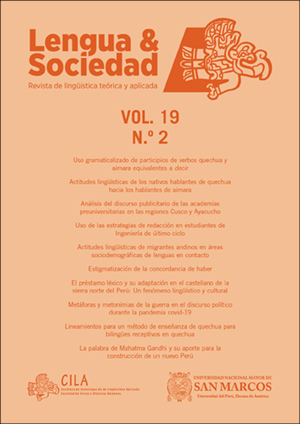Stigmatization of «haber» agreement
DOI:
https://doi.org/10.15381/lengsoc.v19i2.22307Keywords:
haber impersonal, gerund of posterity, grammaticality, prestigeAbstract
The purpose of this paper is basically to give an account about a grammatical form produced within the logic of a natural language as Spanish, specifically, agreement between haber and a plural NP. This construction nevertheless is censured with the interest of prestigious and traditional forms, which, across the centuries, grammarians tried unsuccessfully to impose in frequent speech and writing, on grounds of notions of grammaticality that, in fact, do not represent the inner grammar of speakers.
References
Campos, H. (1999). Transitividad e intransitividad. En Gramática descriptiva de la lengua española. Las construcciones sintácticas fundamentales. Relaciones temporales, aspectuales y modales (pp. 1519-1574). Madrid: Espasa.
D’Aquino, G. (2008). El cambio lingüístico de haber impersonal. Núcleo, 20(25), 103-123. http://www.scielo.org.ve/pdf/nu/v20n25/art06.pdf
Demello, G. (1991). Pluralización del verbo «haber» impersonal en el español hablado culto de once ciudades. Thesaurus, 46(3), 445-471. http://cvc.cervantes.es/lengua/thesaurus/pdf/46/TH_46_003_071_0.pdf
Díaz, M.(2003). The Pluralizationof Haber in Venezuelan Spanish: ASociolinguistic Change in Real Time. IULC Working Papers, 3(1), 1-13. https://scholarworks.iu.edu/journals/index.php/iulcwp/article/view/25952/31632
Eguren, L. y Fernández, O. (2004). Introducción a una sintaxis minimista. Madrid: Gredos
Fernández-Soriano, O. (1999). Two Types of Impersonal Sentences in Spanish: Locative and Dative Subjects. Syntax, 2(2), 101-140. Disponible en http://www.uam.es/personal_pdi/filoyletras/fsoriano/Syntax.pdf
Fontanella, M. (1992). Variación sincrónica y diacrónica de las construcciones con haber en el español americano. Boletín de Filología de la Universidad de Chile, 33, 35-46. Disponible en http://www.boletinfilologia.uchile.cl/index.php/BDF/article/viewFile/18908/20027
Garachana, M. (1999). Los procesos de gramaticalización. Moenia, 5, 155-172.
Herrero, F. (2008). Haber, ser y estar como verbos de existencia en el siglo XV. En Olza Moreno, Mauel Casado Velarde y Ramón González Ruiz (eds.), Actas del XXXVII Simposio Internacional de la Sociedad Española de Lingüística (SEL) (pp. 341-353). https://dadun.unav.edu/bitstream/10171/21029/1/Haber%2C%20ser%20y%20estar.pdf
Hopper, P. y Closs, E. (2003). Grammaticalization. Inglaterra: Cambridge Universty.
Lamiroy, B. (2004). La teoría de la gramaticalización y su aplicación a las lenguas románicas. Estudios de Lingüística: El verbo, anexo 2, 245-266.
Luque, J. (1978). En torno al sintagma «haber impersonal + sustantivo» y sus orígenes latinos. Revista Española de Lingüística, año 8, fasc. 1, 125-147.
Montes, M. (1994). La concordancia con haber impersonal. En Anuario de Letras. 32, 9-35 http://www.revistas.unam.mx/index.php/ral/article/view/37817
Moro, A. (2008). The Boundaries of Babel. The Brain and the Enigma of Impossible Languages. Londres: MIT Press.
Real Academia de la Lengua Española (2013). Diccionario de la lengua española. Vigésima segunda edición. Recuperado el 13 de mayo de 2013, de http://lema.rae.es/drae/?val=haber
Rodríguez-Mondoñedo, M. (2005). Case and Agreement in Spanish Existencial Constructions (and beyond). Disponible en http://ling.auf.net/lingbuzz/000164/current.pdf
Downloads
Published
Issue
Section
License
Copyright (c) 2020 Víctor Arturo Martel Paredes

This work is licensed under a Creative Commons Attribution 4.0 International License.
AUTHORS RETAIN THEIR RIGHTS
a. Authors retain their trade mark rights and patent, and also on any process or procedure described in the article.
b. Authors can submit to the journal Lengua y Sociedad, papers disseminated as pre-print in repositories. This should be made known in the cover letter.
c. Authors retain their right to share, copy, distribute, perform and publicly communicate their article (eg, to place their article in an institutional repository or publish it in a book), with an acknowledgment of its initial publication in the journal Lengua y Sociedad.
d. Authors retain theirs right to make a subsequent publication of their work, to use the article or any part thereof (eg a compilation of his papers, lecture notes, thesis, or a book), always indicating its initial publication in the journal Lengua y Sociedad (the originator of the work, journal, volume, number and date).



























